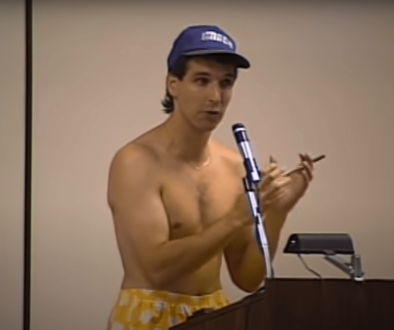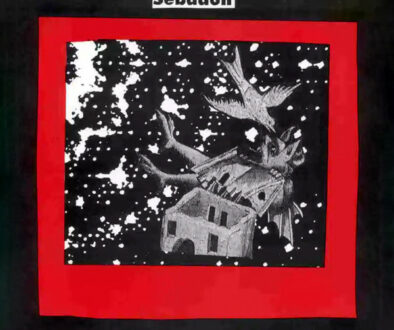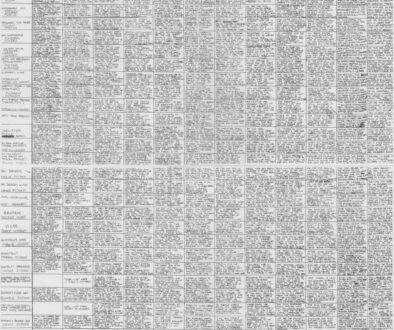Tombs and Seances and Murders (Book Three, Part 69: Brought to Light)
Previously in The Last War in Albion: Moore made savvy use of his artist in Brought to Light, offering a wordy and dense history of the CIA for Sienkiewicz to offer his abstract and often terrifying illustrations to.
You wonder why the children of America are obsessed with death? You wonder why rock groups that look like corpses and zombie comic-book heroes are so goddamn popular here? It’s just the same way your Victorians loved their tombs and seances and murders. The American Empire is dead and does not know it. Like your empire before it, it’s only aware of the truth in its sleep.” – Grant Morrison, The Invisibles
The eagle presents himself as a salesman, and launches into a pitch, though for what exactly is not clear. The content, however, is a history of the CIA, narrated to the reader over twenty-one of the comic’s thirty pages. This is a complicated frame for a story that could have been presented more straightforwardly, but it gives Moore several advantages. The eagle functions as an unreliable narrator—a point that’s made emphatically clear at the outset, when he talks about the CIA’s relationship with Congress in terms of how “My wife, she holds the purse strings, see? I gotta account for every cent. As for laying down the law… hell, she practically drafted a Bill ‘o Rights!… Bitch watches my every move. Still, there’s ways an’ means. What she don’t know ain’t gonna hurt her.” (This stylized dialogue provides the unquestionable highlight of the Gary Lloyd audio adaptation, with Alan Moore voicing the eagle in a style that could be described as “the voice he’d developed for ‘Old Gangsters Never Die’ on several lines of cocaine” but is frankly far better simply sought out and experienced for one’s self.)

This gave Moore three separate ways of revealing information. On the most basic level, he could simply have the eagle convey some historical fact—for instance, that “over in Cuba this friendly dictator named Fulgencio Batista ad been running things along with Santos Trafficante, the Mafia’s man in havana, Cuba’s capital. Batista ignored the drugs, gambling, and prostitution for a cut of the profits… Suddenly, in 1959, this socialist, Fidel Castro, an’ his buddy Ché Guevara overthrew Batista in a so-called popular revolution. Under Castro, Trafficante and the mob hadda leave Cuba.” But he could also lean into the eagle’s status as an unreliable narrator, such as the following sentence, “Say watcha like, the Mafia represent free enterprise, which we, as a company, are sworn to protect.” On top of this, he still has Sienkiewicz’s illustrations, so he can then devote two panels to the eagle lighting a cigar (“Havana cigars—best smoke inna world”) and taking a long drag on it, implicitly commenting on the way in which the CIA and its officers enriched themselves on Cuba.

The unreliable narrator also allows Moore to inject some humor into what is not exactly inherently entertaining subject matter. So, for instance, talking about the use of a Pepsi bottling plant in Laos as a front for a heroin-running operation, Moore has the eagle dryly remark that “later we decided that things went better with Coke.” And when it then comes time to talk about the cocaine operation in Latin America and how it was used to launder money, he notes that “nobody could figger out how we supplied our Contras. Heh heh… lemme tellya’ secret… s’all done with mirrors.” (Credit must also be given to Sienkiewicz, who handles “coked out bald eagle” with suitably visionary aplomb.) This is substantially more entertaining than a history of murderous government drug-running should be, without really detracting from the horror of it.

The book’s most chilling bit of dark humor, however, comes in a recurring motif where Moore describes the death tolls of various CIA operations in terms of how many swimming pools full of blood they’d produce. Again, Sienkiewicz nails all sides of this, first introducing the image with a panel of the eagle lounging on an inflatable pool raft atop pool of blood, then in later iterations, simply depicting a series of red rectangles with simplified white diving boards at the top for however many swimming pools of blood a given operation yielded. Moore’s payoff for this gruesome running gag comes, inevitably, with the La Penca bombing as he has the eagle sneeringly note “Five journalists? Shit—that’s hardly a puddle.”

The comic as a whole, meanwhile, concludes with the eagle finally explaining what he’s selling. “It’s like this… we never assassinated anybody, never smuggled drugs, laundered money, or conspired with criminals an’ dictators. What really happened, America protected the world. The CIA protected America. Shackley, Clines, anna rest protected the CIA. And that’s why they’re goddamn heroes. That’s it. That’s what I’m selling. You buy that, doncha?” As for the price, it’s simple: “your indifference. Just turn away. Pretend it ain’t happenin.” And the eagle opens his case, revealing the wares inside, and Moore, for the first time in dozens of pages, has Sienkiewicz drop out of the eagle’s crazed, hyper-exaggerated speech bubbles, returning to the even, typewritten text of the initial narration to describe what’s inside. “My Lai, the massacre North didn’t see: the baby crawling, a soldier squinting, sighting. ‘He fired at it with a .45. He missed. We all laughed. He got up three or four feet closer and missed again. We laughed. Then he got right on top and plugged it.” The eagle holds the case open, blood pouring out, and says to look closer. Again, Sienkiewicz drops to the plain, type-written text, the color draining out of his art to offer something more stark, monochrome, not quite realism, but more real, more substantial. “The Nicaraguan farmer, interviewed in 1985, shot by the Contras with his son, who died there in his arms. Recovering consciousness, he found that pigs were eating his child’s brains. ‘Rosa had her breasts cut off. Then they cut into her chest and took out her heart.’ How much? How much blood can there be? How many pools?” Instead the narratee flees the bar, back out to the harbor, desperately looking to get out of this nightmarish realm. Nevertheless, the narration stresses one more time, “This is not a dream.”
All of this, it is clear, was somewhat puzzling to Daniel Sheehan, who presumably did not have anything like this in mind when he signed off on a comic to fundraise for the Avirgan v. Hull case. His introduction to the comic is blatantly bemused—after describing “Flashpoint: The La Penca Bombing” as representing “in pictoral form, the factual data supplied to author Joyce Brabner and artist Thomas Yeates from the investigation and litigation of the Christic Institute and Martha Honey and Tony Avirgan,” Sheehan describes “Shadowplay: The Secret Team” as being “of a very different nature,” noting that Moore and Sienkiewicz “have exercised their judgment in a way very different from that in which this information has been historically presented by the Christic Institute.” There is a clear sense of ambivalence here, even as Sheehan defends the way in which the comic is “shocking and violent“—a sense that Moore and Sienkiewicz turned in something rather stranger and more artistic than the law firm was necessarily hoping for.
Or perhaps the matter is more complex and yet also more fundamental than that. Sheehan notes, with some consternation, that “unlike the public presentation of the Christic Institute” the comic “depicts the symbolic ‘salesman’ of the agenda of the shadow government as vicious, confused, and violent,” stressing that “To our knowledge, none of the defendants is personally any of these things” while acknowledging that “the conduct attributed to certain of the defendants by specific evidence in the Christic Institute case does clearly generate torture, murder, and destruction.” Ultimately, Sheehan heads in the direction of focusing on the words “vicious” and “violent,” presumably anxious that Oliver North will add further insult to injury with a libel suit or something.
In practice, these consequences were minimal. Moore reports having “had a couple of neighbors come to tell me independently that their house had been approached by the police wanting to use it as a surveillance point for my house across the street. But nothing happened.” Sienkiewicz, meanwhile, described how “for a period of a couple weeks there was an unmarked white van that was parked across the street, and there were no other cars around. And there were a couple of times when I got a phone call and I would pick it up, and I would hear the last conversation I had, like the tail end of it, and then the line would go dead. I don’t know if any of that… I’m not going to talk about lizard people or go all Alex Jones, but there were some weird things that happened.” But this was the extent of it—some odd and slightly ominous events, but no sustained consequences for any of the people involved, and certainly no retribution for its characterization of specific people.
Upon reflection, then, the key word in Sheehan’s diagnosis was not “vicious” or “violent,” but rather “confused,” a word that cut far closer to the heart of the Christic Institute’s claims about the CIA and what was wrong with them. For all that Moore and Sienkiewicz’s comic bore the name “The Secret Team” and was nominally the half of the presentation focused on the sprawling conspiracy theory, Moore’s script mentioned the concept not once, and the idea of a shadow government is only fleetingly alluded to. More to the point, however, Moore’s view of the CIA is in a fundamental way antagonistic to Sheehan’s vision of it as a vast shadow government pulling the real strings of power. In contrast, Moore’s eye is pulled towards the fact that for all of the CIA’s schemes, they always fuck it up. For all their cruel malfeasance and ambitious schemes, most of their plots failed. Their support for the Shah of Iran crumbled within a few decades. Their efforts in Syria failed. Their support of Batista in Cuba failed, and their repeated efforts to assassinate Castro were so botched as to tip into actual comedy. The entire Nicaragua situation arose because of their failure to keep Somoza in power, and for all their they never actually took down the Sandinistas.
Moore doesn’t just tell the story of these repeated debacles, he makes it clear that the underlying reason for them is the egregious incompetence of the CIA. The use of the drug-addicted and blatantly crazy eagle narrator as a metonym for the CIA does not merely portray them as “vicious, confused, and violent,” it portrays them as comically inept and no less dangerous for it. (As Moore put it in a later interview, “If you are on a list targeted by the CIA, you really have nothing to worry about. If however, you have a name similar to somebody on a list targeted by the CIA then you are dead.”) One of the key ways the eagle is unreliable as a narrator is his ridiculous hubris, saying things like “S’funny… our assassination programs always look great on paper, but then, I dunno… y’get these goddamn uprisings… maybe we’re just not assassinatin’ enough people.” The overall portrait sits at an uneasy tension with Sheehan’s preferred narrative. This isn’t a terrifyingly capable shadow government—it’s just a bunch of idiots with delusions of grandeur.
This difference of opinion never amounted to any sort of rift between Moore and the Christic Institute—Moore noted after the fact that he took the project in part “because the Christic Institute sounded like a fundamentally decent bunch of people, as indeed they proved to be when I did go over there and visit them.” This marked Moore’s final trip to the United States, accompanied by Deborah Delano, and met Harvey Pekar, attending a Washington D.C. stage adaptation of American Splendor. Nevertheless, it is clear that Moore came to see the CIA very differently than his employers. The Christic Institute’s version of the story required them to be the bold crusading heroes, which in turn required clear villains whose misdeeds they could stop. More to the point, their rhetoric served to glamorize the villains of the story, elevating them into the true puppetmasters running the world. Moore saw no glamour in the evil, however—only cruelty and stupidity.
In many ways more significant, however, is the overall worldview that Moore took from his research for the comic. He summed this up in a later interview, noting that “What I learned during the frankly horrifying research that I had to slog through to accomplish this, was that yes there is a conspiracy, in fact there are a great number of conspiracies that are all tripping each other up, and all of those conspiracies are run by paranoid fantasists and ham-fisted clowns.” To Moore, however, this was scarcely a comfort. In his view, “The main thing that I learned about conspiracy theory is that conspiracy theorists actually believe in a conspiracy because that is more comforting. The truth of the world is that it is chaotic. The truth is that it is not the Jewish banking conspiracy or the grey aliens or the 12 foot reptiloids from another dimension that are in control. The truth is far more frightening: nobody is in control. The world is rudderless.”
In time, however, Moore would come to realize that the world’s rudderless nature was less a deep source of horror than a new sort of job opportunity. For that, however, further evolutions to his world view would need to take place. [continued]





July 4, 2023 @ 6:11 pm
Instead the narratee flees the bar, back out to the harbor, desperately looking to get out of this nightmarish realm.
“Oh, to be gone from here, to a place where things are sometimes done in kindness…”
July 8, 2023 @ 4:25 pm
“…and for all their…” what?